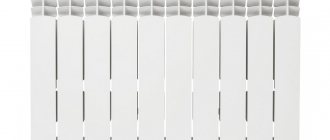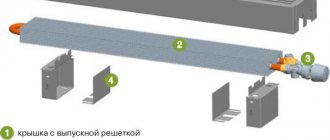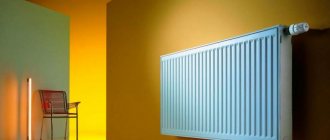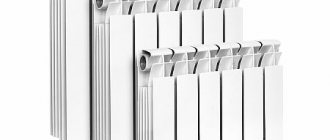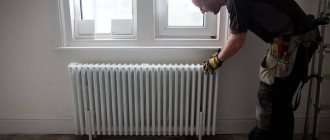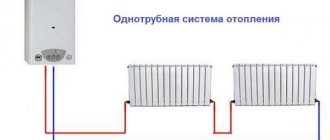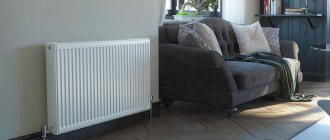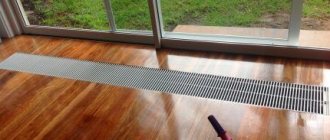Heating equipment mounted on walls and ceilings, including portable heating devices, to a certain extent is an integral part of the interior, requiring decoration and occupying some volume in the room.
With the development of technologies for the production of heating equipment, units have appeared on the heater market that do not reduce the usable volume of the premises - heating convectors built flush into the floor.
Group sequential arrangement under a common grille of convector-type heaters installed in the floor along the perimeter of a circular arrangement of panoramic window openings
In-floor heating convectors are widely in demand in spacious administrative and residential premises with glass enclosing structures, as well as public transit structures (corridors, passages, waiting rooms), where they, without being conspicuous, effectively fulfill their purpose - maintaining the required temperature regime.
In-floor convector heater mounted along the observation external glazing of the room.
What functions do convectors perform?
Due to the rapid popularity of these systems, you need to study all the existing functions of convectors to fully ensure that this system is suitable for heating your house or apartment.
Among the main functions of convectors are:
- Heating functions. The convector is designed to create heat in rooms. At the same time, this heating will not dry out the air.
- Prevention of fungi and dampness. This option exists if the system was installed near a window.
- Underfloor heating. This function allows the consumer to install the system on the floor, which will not take up much space and will look more aesthetically pleasing than conventional heating radiators.
Floor heating convectors that are built into the floor will look great in rooms designed in a minimalist style.
Management in what cases is it necessary?
When choosing convectors with additional convection, you always need a thermostat and a transformer (current converter). Convectors with natural convection can be controlled mechanically, for example by a thermal head (5 speeds).
Types of heating convectors
In the heating systems market, manufacturers from year to year try to diversify their range with new models of convectors, which differ in functionality, size and operating principle.
The most popular are:
- Convectors that provide for natural convection, that is, natural circulation of the air mass. Devices of this type carry out heating using heat exchangers, with the help of which there is a gradual natural movement of the air mass to the upper zone of the premises. This operating principle ensures gradual heating of the entire area of the room.
- Convectors with a fan. A distinctive feature of this device is the forced circulation of the air mass using a special fan. At the moment, this is the most popular convector system, because it provides complete heating of the room in a very short time (from ten to fifteen minutes). At the same time, the disadvantage of such a convector is the dust that the fans raise.
At the same time, there are a couple more types of convectors:
- Built-in water convectors in the floor. From the name you can understand that heating occurs using water. In order to withstand heat, the grilles of such convectors are made of heat-resistant materials. It is worth noting that the installation of this system is very complex and resource-intensive. This system is attractive because the cost of maintaining such a system is much lower than that of electrical systems. In general, the advantages of this system include unique compatibility with any floor, cost-effectiveness and efficiency, the ability to use such a system as the only source of heating in a house or apartment, and does not create dryness in the air. Among the disadvantages of this system are the complexity of the installation process and the need for specialist help, because installation work can really cause difficulties.
- Built-in electric convectors in the floor. This system operates on tubular electric heaters; the only condition for installing this convector is free access to electricity, that is, accessibility to electrical networks. In general, this system is much easier to install than water convectors, but is more expensive.
Baseboard heating with compact radiators
Low and compact heating devices are placed along the baseboard around the perimeter of the room. This system has an interesting feature - it uses the property of warm air that rises along a vertical surface to not form intense convection. The flow “sticks” to the wall, heats it, and then due to radiation and slight mixing of the air, the room is heated.
The effectiveness of this solution is achieved only if the heat transfer is correctly calculated: if the length of the plinth elements exceeds 15 m, then it is necessary to install a distribution manifold so that the coolant does not cool down at the far end of the radiator. The big advantage of the system is the ability to maintain the temperature within 40-50 °C for good heating, since the area of the heat source is large. A noticeable drawback is the impossibility of installing furniture along the walls, since heat transfer will be sharply reduced. The price of a baseboard heating radiator is higher than the cost of traditional products. Maintenance of the system is not difficult; installation is possible without recessing it into the walls. Mainly used in public buildings with open baseboards.
How to choose the right convector
To clearly understand what a convector is and what parameters to pay attention to, you need to study the list of technical characteristics that are important:
- Power indicators. One of the most important parameters in a convector, because the higher this indicator, the more efficient the heating of the room will be.
- Dimensions. You should pay attention to this indicator if you have already prepared a special in-floor niche for the device. Also pay attention to the size of the room itself.
- Compliance with quality standards. When purchasing a convector, you should pay attention to whether it has the appropriate documents that confirm the device’s compliance with state quality standards.
Crimping pressure indicators. This indicator must correspond to the pressure of the central heating system.
Selection technique
The main criterion for choosing a floor convector is its thermal power, as for any other heating device. To accurately determine it, thermal-hydraulic calculations are performed, which take into account, among other things, the area of the room, the height of the ceilings, the level above the ground (number of floors), the presence of additional heating devices, thermal insulation, etc. This is the job of heating specialists, which should be included in the project buildings and for which, accordingly, you have to pay.
Most private developers neglect this, wanting to save money, and use the average statistical data for our latitudes. Thus, 1 kW of device power per 10 square meters is considered sufficient to ensure thermal comfort. m. area of the room. That is, for a room of 25 square meters. m. you need at least a 2.5 kW convector. The authors of this technique assume that our conditional room is not a corner room (maximum one external wall) and it does not have windows with energy-saving double-glazed windows. Changes in the initial conditions automatically require adjustments to the calculations. So, if the same room was a corner room, then the power would have to be increased by at least 30% to 3.2...3.5 kW. When installing plastic windows, the situation is the opposite - a reduction in the required power of heating appliances by 20-25% to 1.9...2 kW.
In addition, the final power of the convector is affected by thermal pressure - the difference between the temperatures on the surface of the device and the air in the room. According to current sanitary standards, 70 degrees is considered optimal. In practice, a shift in one direction or the other is possible, which also forces one to adjust the power of the device, choosing it, for example, with a reserve. Most manufacturers accommodate customers in this regard by providing calculation tables with the indicated level of heat transfer at a specific temperature drop.
The next step in selecting a convector is to determine the type of convection. As mentioned earlier, if the devices have natural and forced (using fans) circulation. The presence of additional equipment affects the cost of convectors and their thermal efficiency (they increase by 2-3 times). It is recommended to choose natural circulation if the area of the room does not exceed 15 square meters. m. or there is the possibility of installing several heating devices. For areas over 15 sq. m. It is better to give preference to models with fans. They are more powerful with similar dimensions, and their operating parameters are easy to control using regulators, thus increasing efficiency.
Next, the overall dimensions are determined based on the following recommendations:
- The length of the convector should be within 70...100% of the length of the window. That is, if the window size is 2 m, then the heating device must have a length from 1.4 to 2 m. These conditions correspond to modifications KE.230.1500.90, KE.230.1750.90 and KE.230.2000.90, the length of which, respectively , 1.5, 1.75 and 2 m (see illustration about the temperature pressure table);
- The width of the convector depends on the manufacturer. The optimal value is considered to be 20-25 cm for devices with natural circulation and 27-32 cm - with a fan;
- The depth of the convector also depends on the design solutions of the manufacturer and can be in the range of 5.5...20 cm. Again, there is an optimal range here - 9-12 cm, which will allow the device to work effectively regardless of the type of convection.
Next, you need to decide on the power management system. The following methods can be used here:
- Manual. Conventional ball valves, valves or thermostatic heads are installed on the pipes connecting the heat exchanger to the system.
- Semi-automatic. At the entrance to the heat exchanger there is a thermostatic valve (including one equipped with a servo drive), which is connected to an external regulator.
Popular convector manufacturers
When purchasing such a device, you need to understand that not every brand is of high quality and safety. Before purchasing, check out the list of the most popular brands.
Among them are:
- Danish manufacturer Devi, which provides a twenty-year guarantee on its products. Systems from this manufacturer are distinguished by high strength, wear resistance and fairly low prices. This brand produces convectors of different types, with different parameters.
- Finnish manufacturer Ensto. This company has been operating since the mid-twentieth century. During this time, this manufacturer has become the largest in the production of heating systems. A distinctive feature of this brand is its full compliance with quality standards, as well as the environmental friendliness of its products.
- English manufacturer Energy. A relatively new company on the market, which has already become one of the best manufacturers of heating systems. These systems are very popular among domestic consumers, since their prices are quite low and the quality is high.
- German manufacturer Rehau. This company was formed back in the twentieth century, during which time the manufacturer managed to surprise consumers with its innovative solutions and quality.
- German manufacturer Kermi. This brand produces high-quality products that become better and better year after year. This manufacturer produces different types of convectors, with different approaches to the device.
What is better to choose – a convector or a radiator?
Heating efficiency and heating quality depend on many parameters:
Compactness and heat dissipation
If we compare the power of in-floor convectors and heating radiators, then a relatively small steel panel radiator type 22 with dimensions of 50 cm high and 70 cm long in power will replace an in-floor convector with dimensions: 9 cm - depth, 25 cm - width, 300 cm - length. However, a built-in convector will cost 5-7 times more.
Heating of large areas
It is worth noting that the efficiency of in-floor convectors with natural circulation depends on the height of the ceilings of the room. Such devices are capable of providing high-quality heating of a room up to 3 m high. Otherwise, we recommend using classic radiators or built-in convectors with forced circulation.
Easy to install and operate
Installation of in-floor convectors allows rational use of room space and does not create large loads on the ceilings and walls of the building. Wall-mounted batteries, especially cast iron models, require reinforced mounting structures. However, in terms of maintenance, radiators are more practical, which cannot be said about in-floor radiators. Convectors create conditions for the movement of dust in the air and require constant cleaning.
Design solutions
Currently, the heating market offers a wide variety of design radiators and attractive, stylish interior solutions. When choosing, be guided by your preferences and desires.
Advantages and disadvantages of convectors
When deciding whether to purchase such a device or not, you need to carefully study all its advantages and disadvantages.
The advantages of this device include:
- High power levels.
- Quite a simple installation and setup process.
- Multifunctionality of the device.
- Compliance with all quality and safety standards.
- Huge selection of device designs.
- The ability to retain heat in rooms for a long time.
Among the disadvantages are:
- Not all devices will be able to provide enough heat to be the only, main source of heating in the room.
- Creation of dust and mud flows, which necessitates regular and frequent cleaning.
The need to call a specialist for high-quality installation and configuration.
Features of design and choice of dimensions
When developing devices, the basic technical requirements for heating systems are taken into account - convectors operate with coolant temperatures up to 130 C, with a maximum pressure in the system of 15 atm. This solution is suitable for private houses, cottages and townhouses, buildings 5 floors high with central heating.
When choosing a convector, you should use a system for calculating thermal power so that all the capabilities of the device are revealed and a comfortable temperature level is maintained in the room. Ceiling heights of more than 3 m and the presence of French glazing require the use of convectors with fans, despite the fact that they are large in height and depth.
Photos of floor heating convectors
Types of convector heaters
Above we talked about heating devices that run on water. But there is another type of convectors - electric. The design and operating algorithm are identical, only the heater of the plates is not a pipe with water, but a spiral made of chromium-nickel alloy. The thermal power of the heater depends on the resistance of this spiral.
On the left is an electric heater with natural air flow, the device on the right is equipped with a tangential fan (turbine)
According to the installation method, heaters are divided into 3 types:
- floor;
- built into the floor (otherwise – in-floor);
- wall-mounted
Important point. Please note: all types of convective heaters are located in the lower zone of the room to capture and warm the cold air above the floor.
The floor convector is made in the form of a low, long radiator on 2 legs. Such a device cannot be confused with a regular battery - the body has a rectangular cross-section, and the mesh is clearly visible on top. The heating equipment manufacturer Verano produces an interesting modification of the floor-standing water convector of the Comodo series, made in the form of a bench (shown in the photo above).
Let us briefly list the dimensions and technical characteristics of floor convectors, based on data from the Verano brand. The parameters of heaters from other manufacturers differ little from this list:
- height – from 100 to 300 mm;
- width (depth) – 150…290 mm;
- heaters length – 0.8…2.6 m;
- height of hidden mounting consoles (legs) – 10 cm;
- working pressure – 10 Bar, test pressure – 17 Bar;
- Connection method: bottom, side.
In-floor heaters are built into the floor screed or window sill.
The efficient operation of such a device is ensured by a fan; the natural movement of air in this case is difficult. The power of a floor-standing convector depends on the size of the heat exchanger, usually increasing due to the length. The dimensions of wall-mounted units vary greatly depending on the manufacturer. Models built into the floor deserve a separate description; in this article we are considering surface versions of heaters.
Comment. Installation of in-floor convectors is quite complicated and not always justified. Devices with fans are noisy, but without fans they lose efficiency.
Dependence of price on heater characteristics
The cost of the convector will consist of its following characteristics:
- The pressure used and the heating temperature given;
- Total thermal power;
- Fan noise;
- Their number in the design;
- Average energy consumption;
- Availability of size chart;
- Features of decoration.
Selecting a heater with specific characteristics and so that they correspond to price/quality indicators is not so difficult today - fortunately, most convector models are sold according to the so-called “designer” scheme (the entire device is equipped with the corresponding elements separately).
Regarding prices, we can talk about the rather high cost of the equipment in question in general. For example, even for a brand released in the vast countries of the former USSR, you will have to pay about 16,000 rubles for a sample with a power of 1000 W. In the former republics, production is mainly focused on models for heating a total area of up to 25 meters with a total price of 50,000 rubles.
